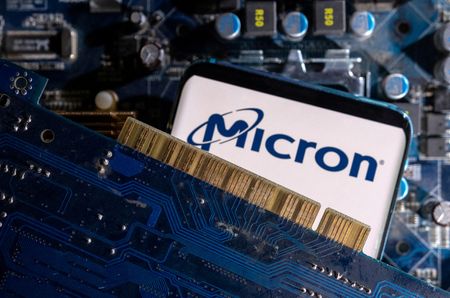By Medha Singh and Aditya Soni
(Reuters) – Memory chipmaker Micron Technology surged to a record high on Thursday after its strong revenue forecast fanned optimism that soaring demand for AI hardware would take the Nvidia supplier to new peaks.
The stock was last up 15%, lifting the broader Philadelphia chip index 3% higher. Micron, which reports earnings before its peers, helps in gauging broader semiconductor demand.
The company said on Wednesday its high-bandwidth memory (HBM) chips, which refer to ultrafast semiconductors used in the development of AI applications, were sold out for 2024. A majority of its 2025 supply has also been allocated, it added.
“Memory is a key beneficiary of AI adoption and we expect a V-shaped recovery in the industry, with revenues expected to grow by 55% in 2024 and 35% in 2025,” said Mark Haefele, chief investment officer at UBS Global Wealth Management.
Micron, one of the two suppliers of HBM chips to Nvidia along with South Korea’s SK Hynix, was set to add nearly $16 billion to its market value, based on its share price of $110.92.
On Wednesday ahead of results, Micron was trading at about 24 times its 12-month forward earnings estimates, compared with 14.53 for smaller rival Western Digital.
Micron’s shares have surged more than 60% in the past 12 months, buoyed by investor confidence that the company will grow its share of the high-margin HBM market this year and the next.
Micron’s chief business officer, Sumit Sadana, told Reuters on Wednesday the company had signed up new customers for its HBM products that it was yet to announce.
Its current-quarter forecast for adjusted gross margin of 26.5%, plus or minus 1.5%, was also above market estimates of 20.8%, as the relatively new HBM chips are in short supply, giving companies such as Micron more pricing power.
“Tight supply, increasing demand, normalization of excess inventory coupled with the increased size of HBM is driving dramatic improvements in pricing,” Piper Sandler analysts said.
(Reporting by Medha Singh in Bengaluru; Editing by Pooja Desai and Shinjini Ganguli)





